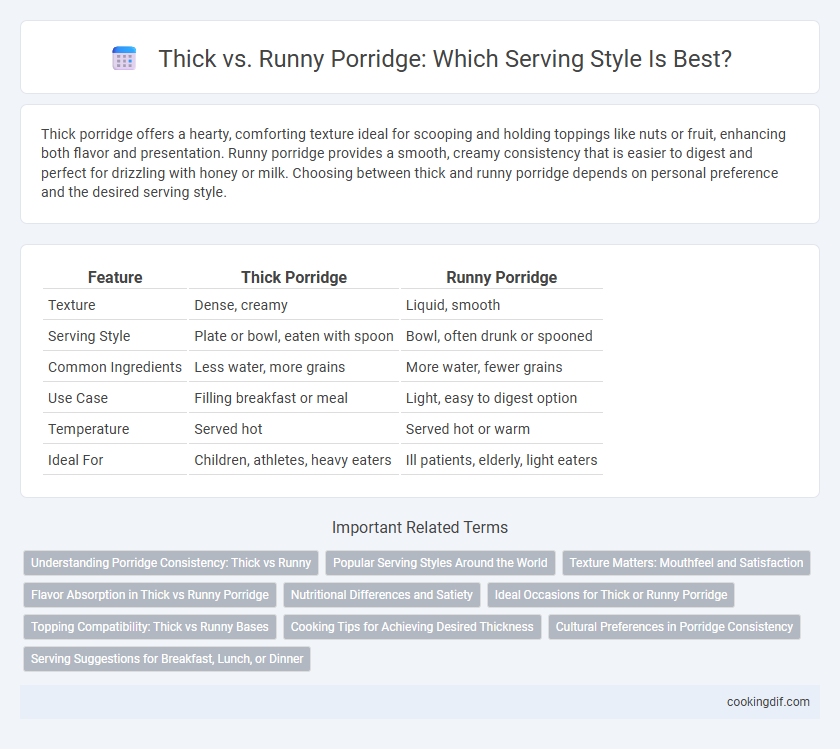Thick porridge offers a hearty, comforting texture ideal for scooping and holding toppings like nuts or fruit, enhancing both flavor and presentation. Runny porridge provides a smooth, creamy consistency that is easier to digest and perfect for drizzling with honey or milk. Choosing between thick and runny porridge depends on personal preference and the desired serving style.
Table of Comparison
| Feature | Thick Porridge | Runny Porridge |
|---|---|---|
| Texture | Dense, creamy | Liquid, smooth |
| Serving Style | Plate or bowl, eaten with spoon | Bowl, often drunk or spooned |
| Common Ingredients | Less water, more grains | More water, fewer grains |
| Use Case | Filling breakfast or meal | Light, easy to digest option |
| Temperature | Served hot | Served hot or warm |
| Ideal For | Children, athletes, heavy eaters | Ill patients, elderly, light eaters |
Understanding Porridge Consistency: Thick vs Runny
Thick porridge offers a creamy, hearty texture ideal for holding toppings and providing sustained energy, making it a popular choice for traditional breakfasts. Runny porridge delivers a lighter, smoother experience that is easier to digest and often preferred for quick meals or by those with sensitive stomachs. Understanding porridge consistency helps tailor serving styles to nutritional needs and personal preferences, balancing texture with flavor absorption.
Popular Serving Styles Around the World
Thick porridge, favored in countries like Scotland and Nigeria, offers a hearty texture that pairs well with toppings such as honey, nuts, or savory meats, enhancing its nutritional value and satiety. Runny porridge, commonly served in East Asian nations like China and Japan, provides a smooth, easily digestible consistency often accompanied by pickled vegetables or soy sauce, reflecting its role as a comfort food and breakfast staple. These contrasting serving styles highlight cultural preferences and ingredient availability, influencing porridge's global appeal and versatility.
Texture Matters: Mouthfeel and Satisfaction
Thick porridge offers a creamy, dense texture that enhances mouthfeel and delivers a comforting, satisfying experience. In contrast, runny porridge provides a lighter, smoother consistency that is easier to sip and digest, appealing to those who prefer a more fluid serving style. Texture plays a crucial role in satisfaction, as the ideal porridge thickness balances flavor absorption with personal preference for richness or lightness.
Flavor Absorption in Thick vs Runny Porridge
Thick porridge absorbs flavors more effectively due to its dense texture, allowing spices and additives to meld deeply into the grains. Runny porridge tends to dilute seasonings, resulting in a lighter taste profile with less intensity. Choosing thick porridge enhances the overall flavor experience by maximizing the retention and balance of ingredients.
Nutritional Differences and Satiety
Thick porridge contains a higher concentration of starches and fibers, which slows digestion and promotes sustained satiety, making it ideal for longer-lasting energy release. Runny porridge has a higher water content, resulting in lower caloric density and faster digestion, which may lead to quicker hunger return. Nutritionally, thick porridge provides more vitamins and minerals per serving due to reduced dilution, enhancing nutrient absorption and fullness.
Ideal Occasions for Thick or Runny Porridge
Thick porridge is ideal for breakfast meals where a hearty, filling option is preferred, providing sustained energy for long mornings or physical activity. Runny porridge suits lighter occasions such as snack times or for those seeking easy digestion, making it perfect for children or the elderly. Choosing the appropriate porridge consistency depends on individual appetite, nutritional needs, and the time of day, ensuring optimal enjoyment and satisfaction.
Topping Compatibility: Thick vs Runny Bases
Thick porridge offers a robust base that holds heavier toppings like nuts, seeds, and chunky fruits without them sinking, enhancing texture and flavor contrast. In contrast, runny porridge allows for easy mixing of liquid-based toppings such as honey, syrups, and melted butter, creating a smooth, evenly flavored blend. Choosing between thick and runny porridge depends on the desired topping compatibility, balancing consistency with the intended culinary experience.
Cooking Tips for Achieving Desired Thickness
Achieving the desired thickness for porridge depends on the ratio of liquid to oats and cooking duration. Use less liquid or cook longer over low heat to create thick porridge, while increasing liquid and reducing cooking time yields a runnier consistency. Stirring frequently prevents lumps and ensures even texture regardless of thickness preference.
Cultural Preferences in Porridge Consistency
Thick porridge is favored in many African cultures for its hearty texture and ability to hold toppings like nuts and fruits, making it a staple breakfast option. In contrast, runny porridge is popular in East Asian cuisines, where its smooth consistency complements savory ingredients and is often consumed as a comforting meal. These cultural preferences in porridge consistency reflect regional dietary habits and the desired sensory experience during serving.
Serving Suggestions for Breakfast, Lunch, or Dinner
Thick porridge pairs well with hearty toppings like nuts, seeds, and fresh fruit, making it ideal for a satisfying breakfast that fuels the day. Runny porridge offers a lighter texture, perfect for lunch or dinner when combined with savory ingredients such as sauteed vegetables or shredded chicken. Choosing the porridge consistency depends on meal timing and preferred accompaniments to create a balanced dish that meets nutritional and flavor needs.
Thick porridge vs runny porridge for serving style Infographic

 cookingdif.com
cookingdif.com